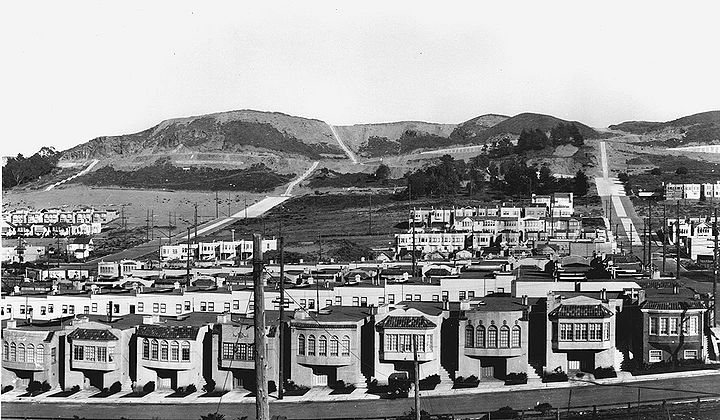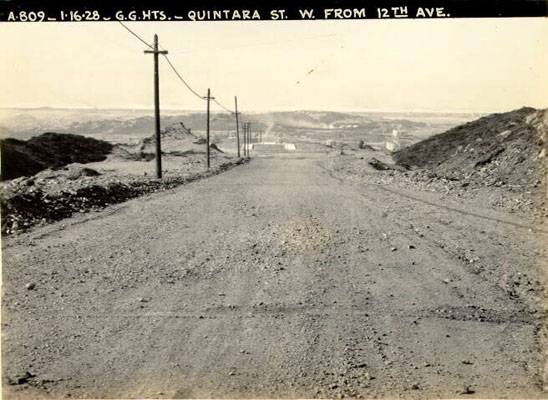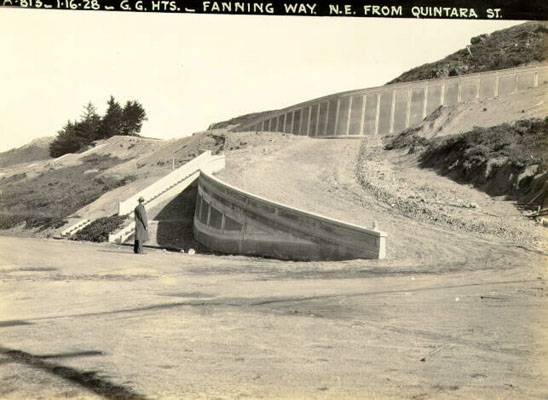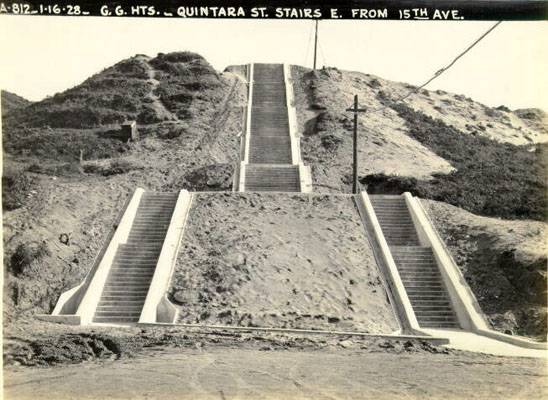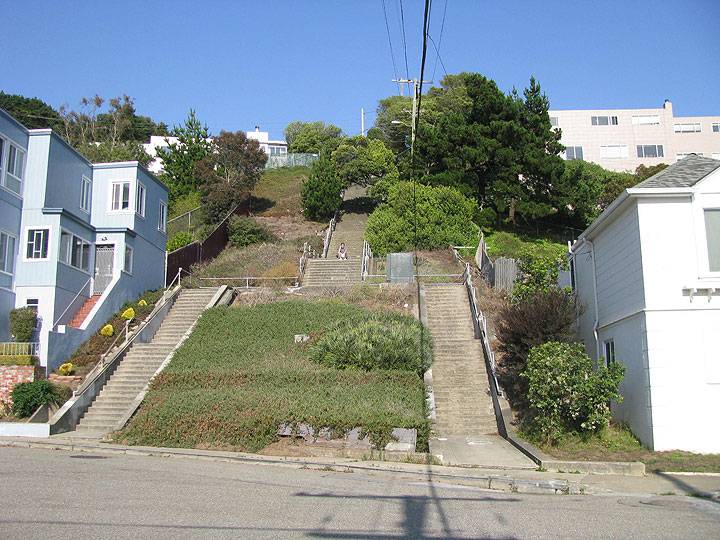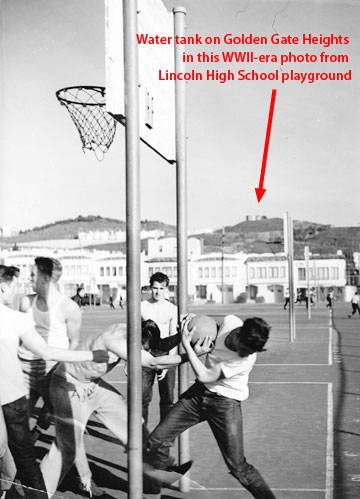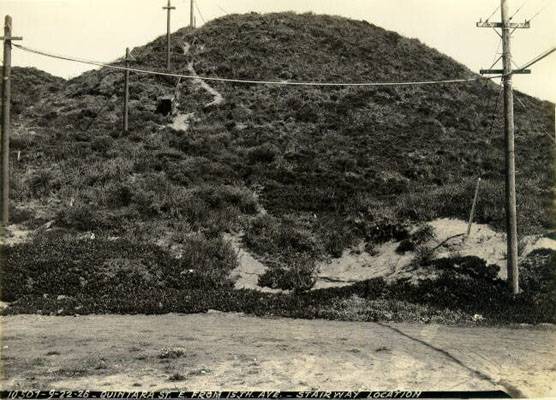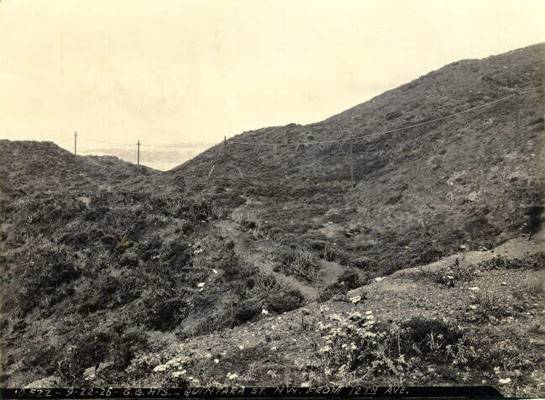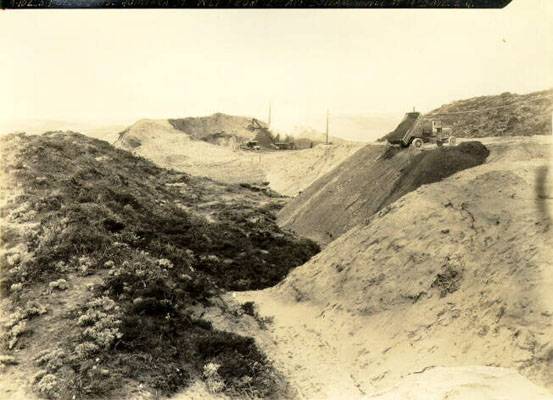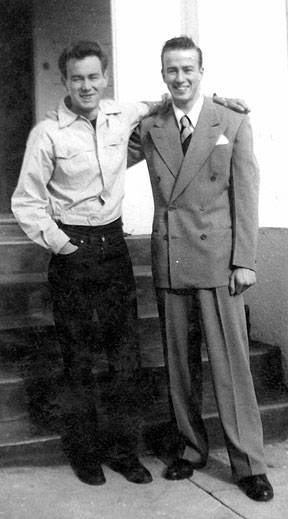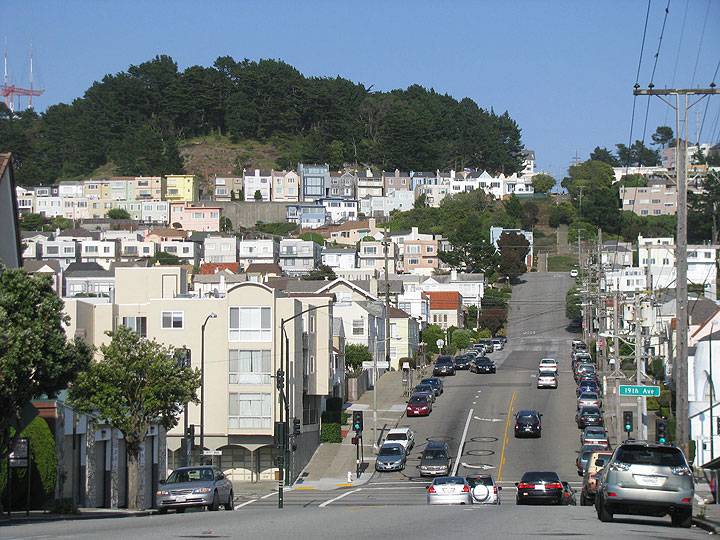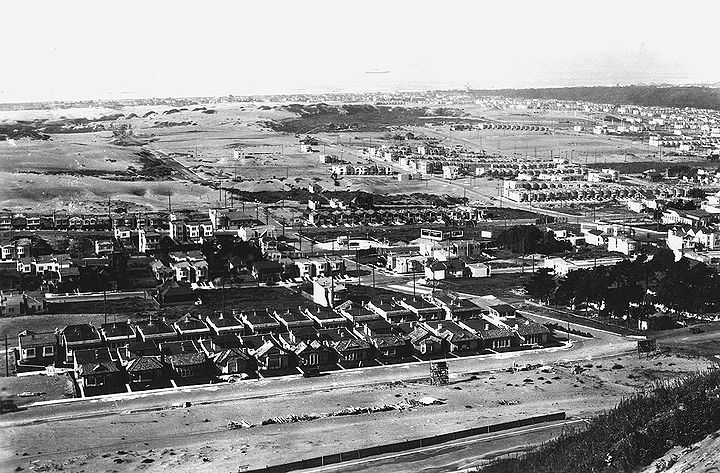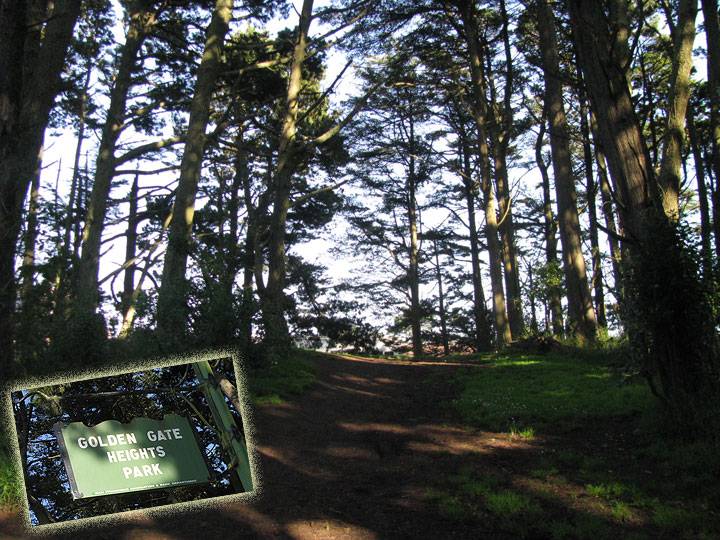Growing up in Golden Gate Heights
"I was there..."
by Dick Boyd
East from 21st Avenue at Pacheco Street with Golden Gate Heights in the distance, February 16, 1928.
Photo: SFDPW, courtesy C.R. collection
I first set my knees and hands on the ground on Otsego Street in the Excelsior District. When I was two (1932) my Dad purchased a two-bed room, one bath house at 140 Quintara Street in the GG Heights. It had been built in 1919. The price was $5,000 bucks. The mortgage was $37 a month. There was a great big house about the same age and just a little more expensive in neighboring Forest Hills. We didn’t buy it because my Mom balked at paying the Forest Hill Assn $7 bucks a month for maintaining the trees, median strips etc. My dad had a large room added on in the back for $500. It served as the bedroom for all of us. At night we used pots stashed under the bed to pee, as there was only one bathroom in the main house. We were supposed to empty them in the toilet but if we could get away with it, my brother and I dumped them out the side window into the lot next door.
View westerly down Quintara Avenue from 12th Avenue, January 16, 1928.
Photo: San Francisco History Center, SF Public Library
For heat we used a stand-alone coal oil burning heater, which we turned off when everyone was in bed. There was no closet added until 1942. This became my brother’s and my permanent bedroom up through 1952. My brother went in the service in 1946 but returned home in 1948 and back to the room.
My grandmother and my grandfather (when he was home) stayed in one of the inside bedrooms close to the bathroom. When my grandfather died in 1937 my grandmother remarried and moved to Oakland and my mom and dad took that room. The other was a permanent guest room or on rare occasion when someone got sick. Usually me. Baths were a Saturday night event for my brother and me together in the same tub. During the week it was face, and hands. My brother and I only had two pairs of shoes, one for school and one for dress occasions. I often wore my brothers’ old shoes after they were half-soled. His feet were growing so fast they were usually in pretty good shape. Mom darned our socks. For heat there was a coal-burning furnace along with a coal bin in the basement. There were 5 vents to heat the house. The stove was gas but had a trash burner that we used in the mornings to heat the kitchen/breakfast room. Toast was made in the lower oven/broiler. My mom’s iron was heated on the stove and she used starch on my dad’s collars and cuffs. There was no refrigerator early on. We had an Icebox. The Iceman delivered the ice as the milkman delivered our milk and coal man delivered our coal.
Our diet was usually pretty stable. For breakfast it was Cream-o-Wheat except on weekends when my mom would fix bacon or ham and eggs with waffles or Aunt Jemimah’s pancakes and of course potato patties from left over dinners. I couldn’t partake of the eggs as the Dr’s said it would/could cause an asthma attack. (It wasn’t until the 60’s that I learned that my asthma attacks were triggered by molds on the linoleum floors in the back bedroom!) There was little waste in our house. For lunch for me it was peanut butter and jelly up through Jr. High and I still like PBJ sandwiches. My afternoon snack was soda crackers smothered in real butter with sugar sprinkled on top. For dinner we always had fresh vegetables. Usually peas, carrots, string beans or spinach. Potatoes were the staple with our evening meal usually baked. During WWII we grew some of the veggies in our victory garden in the back yard. Our meat was usually lamb chops. Sometimes we had pork chops or hamburger steak as my mom called it and sometimes on Sunday a ham. I had my first real steak in 1950. Another staple was “Creamed Chip Beef.” The military had another term for it (SOS) not fit for print in this publication. As many of you my age and older will remember it was a no frills era and there was no TV to tell us that others may be eating better. There was a poor table at West Portal School where kids could put their lunch if they didn’t want it. These were usually kids from St Francis Woods who then could go down to West Portal and buy something different like a milk shake and hamburger. Sometimes I would “exchange” my PBJ for another sandwich like maybe a baloney or ham sandwich. Later when I was in the 4th 5th and 6th grades weather permitting we ate in the yards outside.
Looking at Fanning Way from 15th and Quintara, January 16, 1928.
Photo: San Francisco History Center, SF Public Library
Fanning Way at 15th, 14th Avenue is beneath the wall one block up, August 9, 2009.
Photo: Chris Carlsson
Looking east up the stairs from 15th and Quintara, January 16, 1928.
Photo: San Francisco History Center, SF Public Library
Quintara stairs, August 2009.
Photo: Chris Carlsson
To me Golden Gate Heights (on the southern perimeter) was from where 9th Ave ended at 12th Ave. The eastern edge of GGH was from 8th Avenue (from Kirkham up to Ortega then to 9th) to where it ends 12th Ave. To the West it was 15th Ave from Rivera to Kirkham. Then on the north, Kirkham to 8th Ave and possibly the west side 7th Ave. In between these parameters in the 30’s and 40’s there was a lot of open space.
In the late 30’s there was sporadic homes being built in GGH. We always scavenged left over bits of 2X4’s, sometimes with idea of building a scooter with our old skates or even firewood for the stove, fireplace or furnace. Building began in earnest in the 1950’s although Henry Doelger and a number of smaller builders began right after WWII.
Our house was the next to last house on Quintara. There were three others. The street was made of cobblestone except the gutters and terminated at the end of the 100 block where it became a one-lane dirt road going west. There was no thru traffic on Quintara to the Sunset until about 1938. 10th Ave terminated at Quintara and there was no 11th Ave. At Quintara 11th became Cragmont.
Photo: Dick Boyd
The hill across from our house had a green water tank on top surrounded by a few eucalyptus trees and ice plant to help deter erosion. It was a favorite “dare” to climb up the ladder and look inside. For some reason we never went in the water. As I recall because there was no way to easily get back out. The hill also abounded with wildlife. There were brush rabbits, jackrabbits, skunks, raccoons, mice, gophers and moles. Winged creatures included California Quail, bats, owls, assorted sparrows, hawks, hummingbirds, robins, bluebirds, pigeons and numerous Swallowtails and Lady Butterflies and bees including honey bees, bumble bees, wasps and yellow jackets. Reptiles included lizards and salamanders, gopher and garter snakes.
Quintara stairway location at 15th Avenue, September 22, 1926.
Photo: San Francisco History Center, SF Public Library
Today's Quintara runs along as the telephone in this photo, taken from apx. 12th Avenue looking northwest towards 14th Avenue, also on September 22,1 1926.
Photo: San Francisco History Center, SF Public Library
The hill was a great place to hide if you wanted to. One time for reasons long since forgotten I was mad at my folks. I threatened to run away. So as usual my dad packed a bag, showed me to the door and bade me good luck. Ah but this time I had a plan! I walked down to 10th Ave crossed over to Mendoza and up the hill to the water tank. Then I went down the side of the hill and hid in the bushes where I had a bird’s-eye view of my house and the front porch. I knew my dad was going to sweat me out. It got dark and lights went on in the living room. My mom came out a couple times but never rang her school bell or called my name. I could see my dad in his chair reading the evening paper. Ah success! I was punishing them for whatever transgression they may have inflicted on me. Finally my dad came out and looked around. Oh yes it was working! I had showed them! I was patient though and wanted to continue the punishment. Soon a black and white came up to the house and a cop went to the door. My dad and the cop came outside and had a discussion of some sort. Well I hadn’t expected this turn of events. Now I’m thinking I may have pushed the envelope too far. I decided it was time to end their punishment and hopefully before I really got punished. So I went to the house and rang the bell. My mom answered and I could see her relief. Little Dickie was back. She softly scolded me about this kind of behavior as it really made her worry. I don’t recall what my dad said but I know I didn’t get a spanking. I also didn’t extract any words that indicated he was worried. I guess I had proved a point if only to myself.
The flowers I remember were the lilies, probably planted by my mother or neighbors after Easter, California Poppies, California Buttercups, California Fuchsia’s, California Goldfields, Lupines and the Indian Paint Brush, however there were many others. There was lots of blackberry bushes and some other berries that my mom made jelly with. The bushes were probably California Coyote Brush and others types of brush whose name I can’t recall. There was also Poison Oak. I seemed to be immune to it but my poor brother wasn’t. Occasionally a group of men from somewhere else would go up to the top by the water tanks and then by shouting and beating the bushes drove the rabbits to the bottom where others were waiting with clubs to kill them. This greatly disturbed me but as my mom explained it was the depression. People needed food. She had a way with words. Secretly I hoped they would all get Poison Oak!
Sometimes men would come by and ask her to work for food. She always obliged with some small task outside and provided them with a sandwich of some kind, a glass of milk and maybe an apple or pear. I think a lot of them slept in the abundant open space in the area.
Years later we learned our house and the one at 120, which were identical, were places used during prohibition. The lower house for drinking and gambling and our house for girlies. Celita Bennett and her sea captain husband lived at 120. She was the neighborhood historian and activist and source of neighborhood info. She wanted to see the top of the hill where the water tank was located, preserved for a lookout/park and attended meetings of the planning department where she voiced her opposition to any development on the top. She did this for number of years. Within weeks of her passing away a development was approved. The amazing panorama that stretched along the coast from Thornton Beach and beyond in the South to the Bay Bridge in the East is now available only to those privileged few who live in the 10 or so homes on top.
Below the water tank where 9th Ave and 12th Ave intersected was a rock quarry. Many adults used it for target practice. For some reason no one seemed to use it for dumping which seemed to be reserved for the west side of 12th Ave from Quintara Street. There was also a lookout that extended out about 100 feet that was level and used as a “lovers lane.” This brings up a funny thing a kid named Dickie did when he was about 8 or 9. OK Me! I discovered all these white balloons on the ground; some with funny ends that I envisioned were some kind of special part of these balloons. I gathered all I could and took them home for cleaning and of course reuse. I washed them carefully and then hung them in the back yard on the clothesline. My mom had been somewhere and when she returned home she received a call from a neighbor telling her to check the clotheslines in the back. My mom had me take them down and she disposed of them I know not where. She never really explained why I couldn’t use them other than it was unsanitary to use them again. So much for that opportunity in sex education!
Steam shovel works near today's 14th Avenue while dump truck is on grade of Quintara. Photo taken from apx. 12th Avenue.
Photo: San Francisco History Center, SF Public Library
I went to West Portal Grammar School. At West Portal School I progressed from short pants to knickers and about the 4th grade to long pants. I still have my class pictures from 1935 to 1941. Got my first kiss in the 2nd grade. Her name was Beverly Ward and I still have letters she wrote to me when I was in Shriners Hospital for about a month in the 3rd grade with lots of XXX & OOO’s. I had what the Dr’s said had been a mild case of Polio (I remember my legs aching and my dad would put hot wet towels on them and massage them for me. As it turned out this was part of Sister Kenny’s holistic care for polio victims which the AMA refused to accept and called her a Charlton) and I had developed a semi clubfoot. They corrected it using casts. They would bend my foot to where I could handle it and then put the cast on. When the foot stabilized they would then repeat this until I got my feet corrected. After about a month or so I was able to stay at home with the casts. I think I missed about 3 months or so of school. My mom would go by and see Mrs. Zelinsky my 3rd grade teacher and get schoolwork for me to do so I didn’t get held back. Yeah they did that back then!
In the 30’s there was really no group of kids that lasted very long in my area. For a few years there were about 7 kids my brothers age that hung together. From Mendoza Ave in Forest Hills there was John Hasty whose dad was a big shot at CBS radio station. His older sister Olive Ann sort of looked after me as there were no girls in the neighborhood for her to play with and for a few years no one my age either. No we did not play with dolls! The Hasty’s later moved to NY. On Mendoza there was also Richard Sommers and his older sister Suzanne. One time Richard and I “invented” a flamethrower. We stuck the end of a bicycle pump into a can of gas with the plunger down. By pulling the plunger up it filled the cylinder and hose with gas. While one of us held the pump handle up, the other lit a match to the end of the hose while the other simultaneously pushed the plunger down. The flame would shoot out about 15 feet or so. Well one time when I was on the plunger Richard's hand got too hot so he let the end of the hose go which of course then whipped around and hit my left leg setting it ablaze. Luckily we were in a sandy area and I extinguished the fire by putting sand on my pants. However I had sustained 2nd and 3rd degree burns on my calf.
We were both afraid of getting in trouble. I was really hurting so while we were figuring out what to do we filled his bathtub with cold water and I got in. That really helped and as we now know that was probably the best thing we could have done. Finally we called the lady next door and she called my mom. She told my mom that I had been burned. My mom said well send him home and we’ll take care of it. When the lady said I couldn’t walk my mom almost went into apoplexy but it was a Saturday and my dad was home on the couch with a migraine. He leaped up, drove over, got me, and took me down to Park Emergency on Stanyan Street. It was an owee for a few weeks and I still have the scars to remind me. Strangely enough my dad never suffered another migraine again. Richard and I were in the Boy Scouts, Troop 88 together and he also went to Aptos and Lincoln. We went into the California Division of Forestry (CDF) together in 1944 and both were assigned to Placer County and the Headquarters at Auburn for training. After passing the physical work tests we got assigned to different locations. Back in San Francisco we didn’t really hang out together.
From 10th Ave for a few years there was the O’Reilly brothers Pat and Larry. Larry like me was two years younger so we were inseparable from about 5 years to 7 years old when they moved. One time when running down from the top where 12th Ave ended, we stepped on a ground nest of yellow jackets. We were both stung from head to toe. My grandfather came to our aid and knocked of the bees while getting badly stung him self. He took out as many stingers as he could and then my mom used a poultice of vinegar and baking soda to ease the pain. Just another owee day in the life of Dickie Boyd.
Another time we took a little red wagon, walked down to Pacheco, followed it down to Dewey Blvd, took a right down to Kensington, past West Portal School to Ulloa where we turned right to the West Portal Tunnel. We started to walk in to investigate it but were rebuffed by some adults who stopped us and told us to go home. So we retraced our steps as far as Dewey where my frantic mom intercepted us. We got a stern lecture on the way back home. To this day I don’t think she knew about the West Portal tunnel expedition plan. If you don’t think that’s a long walk for a couple 6 year olds try walking it yourself some day.
Larry’s brother Pat became a Highway Patrolman and “saved my bacon” one time in the 60’s. That’s another story for another time. After the O’Reilly’s moved I spent a lot of time alone wandering around the open spaces available to me. I caught lizards, snakes and some mice which all ended up as science projects at school. I played soldier and explorer and anything or anybody else I could conjure up in my fertile imagination. I knew my end of GGH like the back of my hand.
In the early forties Gerritt Van Raam moved in at 2083 10th Ave. We began being buddies around 1941. I’m not sure where he was going to grammar school then. Later he got a car and when we started Lincoln HS I rode to school with him feeling very important. Later he got a girl friend up in Miraloma Park and I was on foot again. By then Quintara was paved to 14th Ave and I could easily use the staircase down to 15th. The hill between 15th and 16th was real steep. Easy going but a thigh burner on the way home! Gerry later became an SF Policeman, then the FBI and finally a State Narcotics Officer. His life ended in tragedy in the late 80’s when he took his own life after killing his ex-girlfriend and his ex-partner in a jealous rage.
Gerritt Van Raam (left) and Dick Boyd (right) on Christmas morning, c. 1946.
Photo: Dick Boyd
Golden Gate Heights Park at top of hill, north of Quintara, seen here in 2009.
Photo: Chris Carlsson
West from Golden Gate Heights near Pacheco and Funston. Shriners' Hospital at far right, January 16, 1928.
Photo: San Francisco History Center, San Francisco Public Library, courtesy Charles Ruiz collection
In 1940 there was a peacetime draft. The Army put a base on top of the hill where there was a little city park now called Sunset Heights Park. There were two anti aircraft guns installed on the two bluffs and a barracks at the end of 12th Ave that housed about 12 or 14 troops. There was always a jeep and a 4x4 truck parked there. The ranking officer was a Sergeant. That became my hangout whenever I had free time, which was usually.
I was at the Army Barracks on the morning of Dec 7th 1941. Everyone was yakking away and the phone rang. The sergeant answered. All of a sudden he shouted, “Shut up!” Everyone could see the look of alarm on his face and there was dead silence. He hung up and announced that the Japanese had bombed Pearl Harbor and they were on full alert. I took off running thru the lot (on the same trail where Larry O’Reilly and I got stung) down to my house and told my parents. They turned on the radio. I went to the front of the house to tell neighbors and running up the street was Gerry Van Raam screaming out the news. Some of the neighbors came out and a lot of pondering was going on. I’m sure almost all of us remember where we were on that morning.
I remember the FDR’s Fireside chats from the 30’s where we gathered around the radio. On Dec 8th we all listened to FDR read the Declaration of War before a joint session of congress. During the war we kept track of events on the radio and newspapers. The papers all had front-page maps showing how far the enemy had advanced and as the war progressed when the Allies began their offense we saw the areas where we had advanced. They also listed the casualties on the front page when they became available. I delivered newspapers and remember seeing gold stars replace the blue stars in the windows as the war seemed to go on forever. Edward R. Murrows’ broadcasts from London during the Blitzkrieg and H.V. Kaltenborns analyses of the day’s events were a must.
During the war there were contests between the Boy Scout troops to see who could collect the most paper. Our Troop 88 always won. We recycled all the cans and any metal that we could find. There were scrap piles in front of most houses in the outer neighborhoods. I actually got my first bike from a scrap pile in Forest Hills. I was delivering papers on a short street called Cortez saw the bike sans tires. I went to the door and rang the bell. A man answered and when I asked him for the bike he said sure. My dad drove me down later and we got the bike. Then he got some synthetic rubber tires and I was off and running. Americans were aware they were in an all out war. Everyone sacrificed and contributed to the war effort.
I remember Henry Doelger’s wife who was a good looking blonde walking her two Great Danes along Cragmont from her house at the corner of 15th and Pacheco. In that block from Ortega to Pacheco all the mailboxes were mini replicas of the houses they served. From our house at night I remember the sounds of the lions and sometime the elephants from Fleishacker Zoo and also the foghorns. They were sort of my security blanket or tranquilizer tucked away all warm, cozy and secure in my bed. When I heard them I knew all was OK…..at least for me.
There was a junk man that drove his mule and cart up Quintara Street probably on his way to the dump on 12th Ave to “recycle” usable things and dump what he couldn’t sell. He used to call out, “Pow! Pay!” We never knew what that meant. After living in Hawaii and picking up on some pigeon English I learned that what we spelled pow was really pau. Pau meant finished! Duh! So I guess that’s what he was saying. He’d pay for things that you were finished with. There was Bob Watson the security officer who drove around at night using his spotlight to check on ours and other neighborhoods. It was his way of letting us know he was out there on patrol. If you got lucky when he collected his fee he might even invite you to spend some time driving around with him.
On VE Day (Victory Europe) I was in San Francisco but my mom wouldn’t let my brother or me go down town. No doubt a good thing as there were a lot of serious crimes committed along Market Street that night. On VJ Day (Victory Japan) I was in Forest Hill California up in Placer County working as a firefighter for the California Division of Forestry (CDF. It was as wild as it gets in a small town. They rang the town fire bell off and on all day long. Lots of drinking, horns blowing and a couple fights. I found a bar (one of three) that had slot machines that was so busy they over looked me. I found a quarter one where the lever would go down without me putting in a quarter. Whenever we were by a slot machine we pulled the handle just in case. (Like guys used to check the coin return on pay phones. Remember them?) After I got about $18 bucks I got scared and took a hike. I was just 15 and in a bar with a lot of drunk lumber jacks. An interesting fact is that before that day I had never seen any of the black lumberjacks who actually just worked the green chain and stacked lumber in town. Some did venture into town on that momentous day. All of the employees that worked in the lumber business in town were from Arkansas. It was mule logging. That meant that they used mule teams to haul the trees out of the woods and to the mill rather than bulldozers.
Jobs. At one time or another I delivered the San Francisco News, The Call Bulletin (the PM papers), the SF Chronicle and the Examiner (the AM papers). Usually the routes were in Forest Hill (where I remember nesting birds doing touch and go on my head), Golden Gate Heights, West Portal and the Sunset. My Examiner route was the biggest in the city at the time. For that I used the bike that I got out of a WWII scrap metal pile in Forest Hills. I started at 3:30AM and covered from Quintara to Lincoln Way and from 19th to 24th Avenue. I finished at about 7:30AM and nipped the 17 Street Car at Lincoln Way and 20th. It ran up 20th Ave and ended by what is now Sava Pool. I hung on to the cow catcher with one hand and the handlebars with the other. From there it was peddle to Aptos. By 3rd period I was asleep unless it was shop or PE. I lasted about 3 months before my mom called a halt when she saw my report card.
Other jobs during my younger days: I sold Liberty, the Saturday Evening Post, and Colliers (5 cents each) at the Forest Hill Station during the evening when men were coming home from work and door-to-door in Forest Hill. On Saturdays I delivered flowers for Kay’s Florist on West Portal Ave and remember listening to the SMU games on the radio and all about their star Doak Walker. I was using Kay’s old Lincoln. Later I delivered groceries for Morrie’s Grocery Store on 9th and Judah. The truck was an Army surplus 4X4 p/u. Loved going thru the gears!
JP Murphy Playground down on 9th Ave below Pacheco was the closest playground where the directors were Ken Leslie and Jack Ford. I met Jim Ginella my longest & oldest still vertical friend there in about 1944. Other notable guys were Morley Thompson a few years older than me and I think an All-City basketball player for Lincoln and later played for Stanford. Others were Vincent De Nevers (Lincoln), Richard Sommers, (Lincoln), Bob Delaney (Lincoln), and Ralph Sweet (Lincoln or Lowell).
Sometimes two or three of us went to West Portal playground to play football. We did the same on the grass above Forest Hill Station. It was nothing to walk to Glen Park or Aptos for a football “challenge” game. The same for Lincoln HS practice field on Quintara St. and the field out at SF State. Walking places was an accepted way of life for most of as kids. Heaven forbid expecting your mom to drive you someplace. Only “Cherries” got rides from their mom. Today I guess a cherry would be synonymous with a wimp.
After HS I started SF State but continued to live at 140 Quintara Street until the spring of 1952 when I took a job teaching elementary school in Burlingame. During the 50’s I lived there off and on between jobs.
As Porky Pig use to say, “Tha’ tha’ tha’ that’s all folks!”
Golden Gate Heights Park is a lovely forested treasure with incredible views over the western side of the City.
Photo: Chris Carlsson

